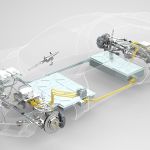Frost & Sullivan finds that COVID-19 has unlocked “massive” opportunities for the connected-car industry due to the significant increase in technology implementation in the space. According to Global Connected Cars Outlook, 2021, demand for innovative features such as health monitoring and non-touch-based haptics such as gesture recognition has increased due to the need for driver protection and risk aversion.
In 2021, the analyst study predicts that global sales of new vehicles with connectivity features are estimated to reach 50 million units after an 8% dip in sales in 2020. With a revenue potential of $15-20 billion by 2025, the creation of software-defined vehicles and innovative business models is more critical than ever, say researchers.
According to the research, the market is undergoing a transformation, and leading automakers are trying to evolve into technology firms, with some of them opting for a collaborative approach to capture market share. Business transformations will occur when the core elements of next-generation platforms and business models are developed and available on vehicles. Technologies such as 5G, widescreen displays, high-performance computers, data lakes, and cloud computing are some of the key requirements and related developments.
“With the rise in demand for innovative features in cars, automakers, suppliers, and technology providers are shifting to new business models, focusing on a software-oriented business approach as a more viable means of revenue generation than a hardware model,” said Ashwini Suvarna, Mobility Research Analyst at Frost & Sullivan. “Over the next three to five years, automakers have to evaluate ideal software strategies to stay relevant and compete, which requires a fundamental overhauling of electrical and electronic (E/E) architecture, operating systems, and cloud competencies.”
Suvarna adds that 5G adoption is accelerating in 2021, and 4-6% of new global vehicle shipments will have 5G-based telematics control units. It will pave the way for data-rich services and vehicle-to-everything (V2X) applications for autonomous driving. With the evolution of the human-machine interfaces, augmented-reality-based central and head-up displays along with digital assistants (based on smartphones) will appear on more vehicle models.
The report recommends that market participants focus on the following growth prospects.
Telematics will be a key ingredient for software-oriented businesses. Technology companies and startups can offer automakers next-generation applications and services and provide a roadmap for implementation in each vehicle type.
For renewed interest in in-vehicle entertainment, suppliers, technology companies, and startups in the consumer-electronics space will have to draft exclusive strategies for connected-vehicle entertainment. This domain holds substantial potential for growth.
Feature-on-demand will generate potential customer hype in connected services. Tier One suppliers must transform their businesses to provide hardware and software solutions, assist automakers in decoupling software, and offer support for the launch in vehicles.
The Frost & Sullivan study, part of its Global Mobility Growth Partnership Service program, includes insights not only on key connected car trends but also those for automotive Internet-of-things; the need for EV services; and regional predictions for the U.S., Canada, Europe, China, Japan, South Korea, Latin America.













































































